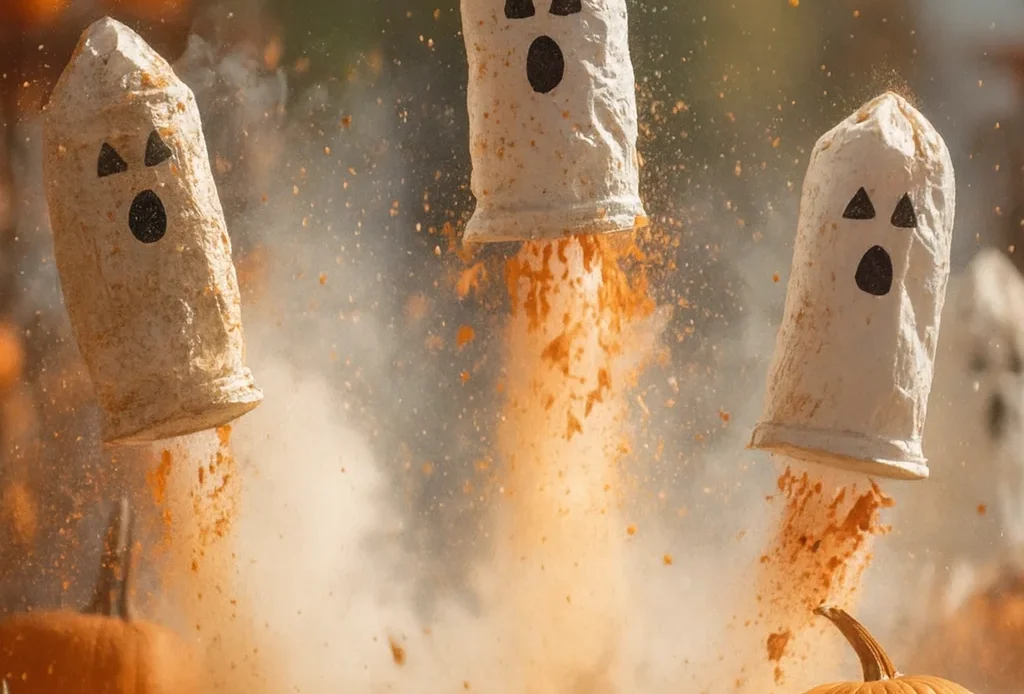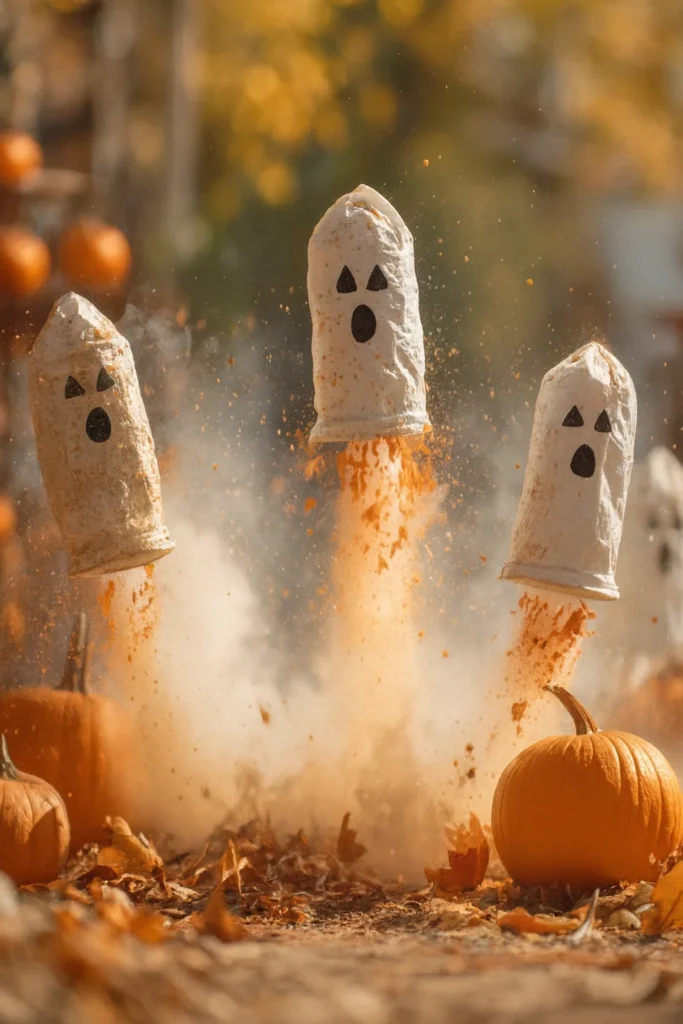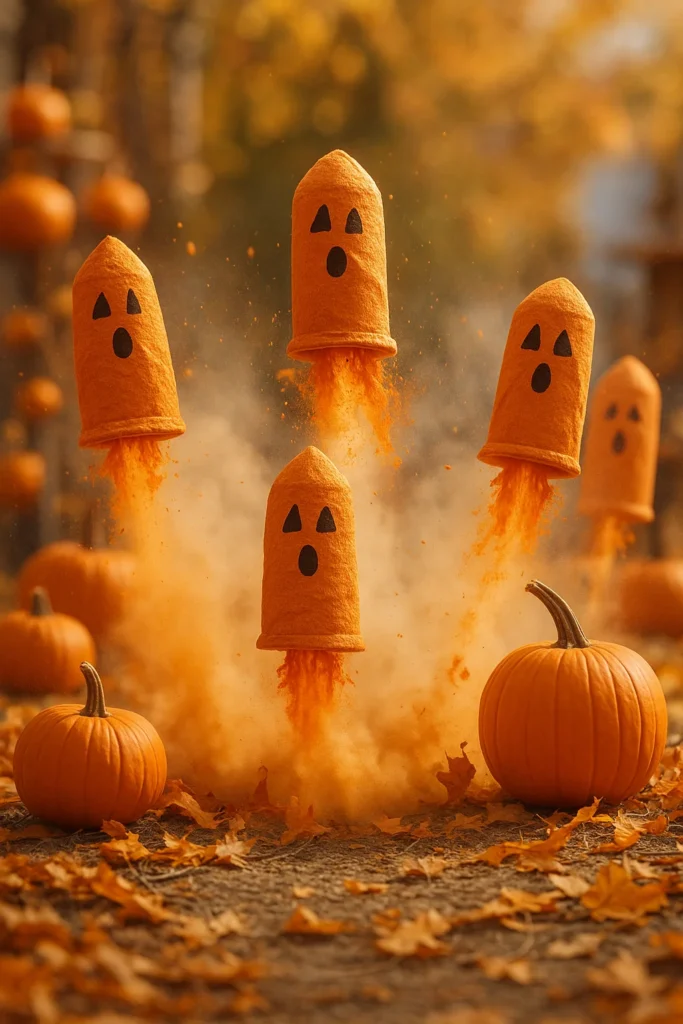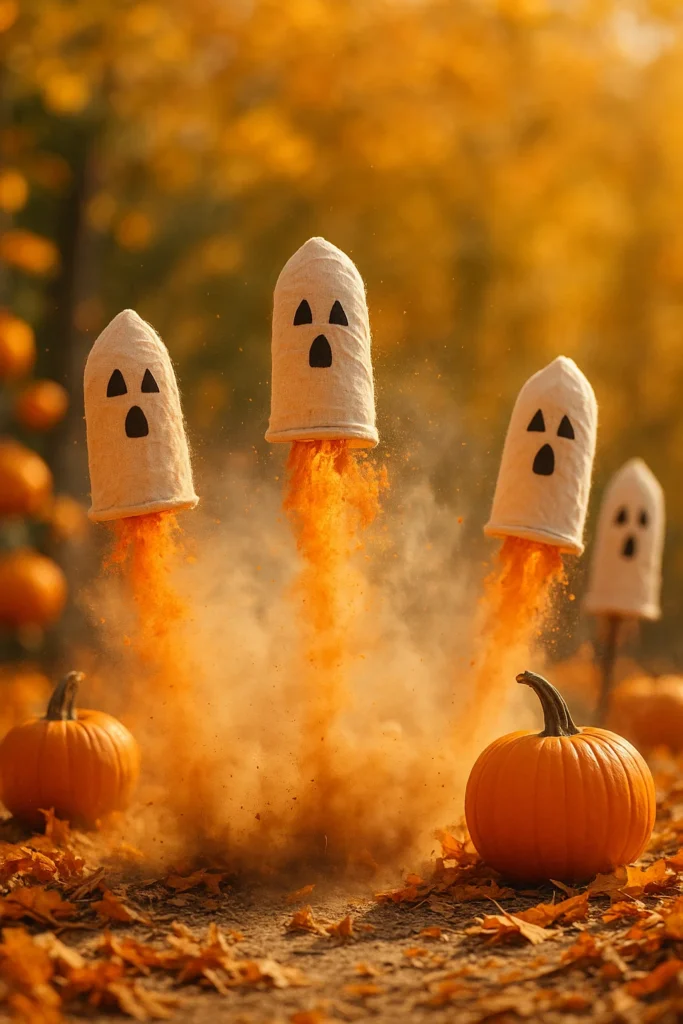
Ever seen a ghost blast off into the sky? No, it’s not magic—it’s science! Ghost Rockets are an exciting, kid-friendly experiment that mixes creativity with chemistry. By combining water and Alka-Seltzer in a small canister, you create gas pressure that launches your paper-wrapped “ghost” high into the air. It’s a perfect Halloween activity that’s as educational as it is entertaining. Whether you’re a parent, teacher, or just a science lover, this spooky project will leave kids wide-eyed and asking for more launches!

What Are Ghost Rockets? (Spooky Science Explained)
Okay, let me paint the picture for ya: it’s late October, the kids are hyped up on candy and chaos, and you need something—anything—that feels festive and keeps them learning. That’s when I stumbled on what might be my favorite fall discovery ever: Ghost Rockets.
I’d seen them fly on Pinterest before, but honestly? I thought they were just another messy Halloween craft. Boy, was I wrong. Turns out, these little guys are a safe science experiment for kids that mixes Halloween magic with a legit chemical reaction project. And the best part? It actually launches. Like, up-in-the-air, stand-back, “woah did you see that?” kind of launch. The squeals from my niece? Worth every second.
The Science Is Actually Kinda Cool
Behind the spooky face and glitter (yes, we added glitter, don’t judge) is a real-deal lesson in gas pressure and propulsion. When you drop half an Alka-Seltzer tablet into water and seal it up in a tight film canister, the reaction creates carbon dioxide gas. The pressure builds until… POP—your ghost is airborne! It’s like a Halloween-themed space launch. Honestly, this should be required in every 4th grade class.
Why It’s the Perfect STEM Halloween Activity
I’ve done a lot of messy science stuff with kids, but this one hits different. It’s simple enough that you don’t need a science degree—or a mop. And it sneaks in some serious STEM learning while still feeling like a party trick.
Here’s why I think it’s gold:
- It shows visible cause and effect.
- It’s a fun science experiment at home that doesn’t break the bank.
- It keeps the kids so engaged they forget to ask for more candy.
- It doubles as a Halloween craft, because the decorating part is just as exciting.
Honest Moment: Our First One Failed 😂
Yep. I didn’t snap the lid on tight enough the first time. The canister kinda… fizzed and fizzled. No pop. Just a sad, soggy ghost laying sideways. But hey—that was a teachable moment too. Now I make sure every kid double-checks their seal before launch. Lesson learned.
It’s More Than Just a Halloween Gimmick
Even after Halloween, we’ve reused the same setup to talk about chemical reactions, force, and pressure. The kids have started customizing their “rockets” with themed art for Thanksgiving and Christmas too. Imagine a Santa rocket. Trust me—it works.
Ghost Rocket Ingredients & Materials List
Alright, let’s talk supplies—because nothing’s worse than hyping the kids up for a launch and realizing you’re out of tape. Trust me, I’ve been there. The beauty of Ghost Rockets is that you don’t need a fancy lab or some overpriced kit from Amazon. Everything fits into what I call my “kitchen drawer of chaos.” It’s truly the perfect DIY science project for kids.
Here’s what I grabbed for our ghostly blast-offs:
Your Must-Have Materials
- 1 Film Canister with Snap-On Lid
This is the engine of your rocket. Don’t mess around with the press-on ones—they leak gas and flop instead of fly. I got a pack of ten online for under $10, and they’ve lasted through many a fizz-fueled launch. - White Paper (or tissue paper)
That’s your ghost skin! We wrapped ours around the canister like a little ghost burrito. Bonus points if you use paper with a bit of texture—it gives it that eerie floaty look. - Black Marker
Because what’s a ghost without a spooky face? We went classic: two big ovals for eyes, one “O” for a surprised mouth. - Tape or Glue
I tried both. Honestly, glue looked better, but tape was easier for the kids. If you’re working with younger kids, go tape. Less mess, less stress. - ½ Tablet of Alka-Seltzer (effervescent tablet)
Here’s where the science kicks in. This is the key to the whole Alka-Seltzer science experiment. Pro tip: pre-snap the tabs ahead of time. Wet hands and rushing kids are a recipe for tablet dust and tears. - 2–3 tablespoons of water
Just enough to dissolve the tablet and build up pressure. I gave each kid a mini measuring cup to pour theirs in—made it feel very official.
Optional But Awesome Add-Ons
- Glow-in-the-dark stickers
Makes it a nighttime showstopper. We did a backyard launch after sunset and whoa, it looked like tiny glowing ghosts shooting stars. - Fine glitter or metallic paint
Not super science-y, but hey, it’s Halloween. My niece named hers “Sparkle Boo.” Who was I to stop her? - Safety Goggles (yes, seriously)
It’s a small explosion. Fun, but still—eyes first. I found a multipack of kid-sized goggles on sale and now keep a pair in our “home science kit” box.
It’s wild how easy this Halloween STEM supplies list is to pull together. I didn’t spend more than $15, and we’ve used the same canisters and leftover tablets for multiple launches. If you’ve got curious kids and a bit of free time, this stuff right here? It’s your ticket to one of the coolest home science kit ideas I’ve ever tried.

Step-by-Step Instructions to Launch Your Ghost Rocket
Now comes the fun part—launch time! And if your house is anything like mine, this is where the kids lose their minds (in the best way). These steps are easy enough for a five-year-old to follow with supervision, but packed with enough wow factor to make adults go, “Dang, that actually worked!”
This easy science experiment for kids only takes a few minutes to prep, but the launch never gets old. I’ve done this dozens of times and still grin like a fool every single time it pops.
Step 1: Decorate Your Ghost
Wrap white paper around your film canister and tape or glue it snug. Then let the kids go wild with the ghost faces. Some drew spooky eyes. Others? Smiley faces, eyelashes, even little bowties. It turned into a craft session real quick.
Step 2: Add the Power (Alka-Seltzer Tablet)
Break your Alka-Seltzer tablet in half (or even quarters if your canister is smaller). Drop it in—but don’t add water yet! One of the kids did this early once and it fizzed in his hand. No harm done, just a lost launch and one very confused ghost.
Step 3: Measure Water
Use a tablespoon to measure out about 2–3 tablespoons of water. This is where it becomes a STEM activity at home—kids can experiment with more or less water and see what changes in the rocket’s launch power.
Step 4: Ready, Set, Launch!
Here’s the step you gotta nail:
- Be outside. Seriously. Do not try this on your kitchen counter.
- Add the water to the canister (quickly!).
- Snap the lid on tight—use your thumbs and press hard.
- Flip it upside down, lid down, and place it on the ground.
- STEP. BACK. FAST.
Within 5–10 seconds—POW!—your ghost will launch into the air with a fizzy little pop that’ll make everyone scream (in delight, not fear).
Bonus Tip: Safety First
I always keep kids at least 5 feet back and remind them not to hover. Even though it’s a safe backyard experiment, that canister can fly a few feet up. And if you’re launching on pavement, make sure it’s not near any cars. One rogue ghost rocket did almost hit my neighbor’s windshield. 😬 Lesson learned.
This Halloween rocket launch is equal parts science and spectacle. And once you’ve got the timing down, the launches get higher and more dramatic. It’s the kind of activity where every kid wants “just one more,” and honestly, so do I.
The Science Behind the Spooky Blast
I’ll admit it—I didn’t really understand what made the Ghost Rockets fly the first time we did this. I just knew something fizzed, and then—boom—the ghost took off. But then my 8-year-old asked, “Why does it explode?” and I realized, okay… time to do some homework. Because this isn’t just a Halloween trick. It’s a legit chemical reaction science experiment.
Here’s What’s Really Happening
So when you mix water with Alka-Seltzer, it causes a chemical reaction that produces carbon dioxide gas. That gas has nowhere to go inside the sealed film canister. As more bubbles form, the pressure builds up… and builds… until the lid can’t take it anymore and pops off. That sudden release of pressure forces the canister—aka your ghost—up into the air.
Basically, it’s the same science behind real rocket propulsion, just way safer (and cuter).
A Teachable Moment Disguised as Fun
What I love most is how this becomes an opportunity for STEM education for kids without feeling like homework. They’re learning concepts like:
- Chemical reactions
- Gas pressure and force
- Newton’s Third Law (every action has an equal and opposite reaction)
- Cause and effect
And it all happens in, like, 30 seconds. No worksheets required.
We even turned it into a mini science fair project. The kids experimented with changing water amounts, switching tablet brands, even trying warm vs. cold water. It became a whole week of hands-on learning at home, and they didn’t even realize they were doing science.
Real Talk: When It Doesn’t Work
One launch totally flopped. It just hissed and fizzed with zero lift-off. Turns out the canister wasn’t sealed tight enough. We used that moment to explain pressure leaks and why sealing the system is crucial in any gas pressure experiment. Kind of like a leaky balloon that can’t fly.
Honestly, Ghost Rockets have given me more opportunities to explain science than most school assignments. And because it’s wrapped in glitter and ghost faces, the kids stay engaged. It’s silly, explosive, and sneakily educational—all the best things in one fizzy package.

Fun Variations & Safety Tips
Okay, so once we nailed the classic ghost rocket, I thought—why stop there? That’s when the kids and I started tinkering, turning it from just a one-off experiment into a full-on creative Halloween activity. The best part about Ghost Rockets is how easy they are to remix. And also? They’re just as fun the tenth time as they were the first.
Variations That Took Things Up a Notch
1. Glitter Bomb Ghosts
We added a pinch of fine glitter inside the canister. When the rocket launched, it left this sparkly trail like a haunted comet. Just don’t overdo it, or you’ll be vacuuming for days. (Ask me how I know.)
2. Glow-in-the-Dark Tape & Stickers
Want to turn it into a nighttime show? Wrap the paper ghost with glow tape or add stickers. Launch them just after dusk. It’s like watching ghost fireflies shoot into the sky.
3. Seasonal Skins
My niece decided one should be a “Pumpkin Rocket.” Another kid made “Frankenstein Blaster.” We just swapped the paper wrapper color and added new doodles. Now we do these for Christmas, Valentine’s Day—you name it. It’s the STEM project idea that keeps on giving.
4. Try Warm Water
Science twist: use warm water and compare the speed. It reacts faster and gives a bigger launch. But fair warning—warmer water = faster reaction = move fast. It surprised us the first time. Real “run-for-it” energy.
Must-Know Safety Tips (Seriously, Don’t Skip These)
I know, it seems harmless. But it’s still pressure-based and popping plastic, so here’s how we keep it a safe science project for kids:
- Always launch outside – Even a little CO₂ pop indoors is just asking for ghost goo on your ceiling.
- Use goggles – I got a cheap kid-sized multipack and now it’s just part of our “science uniform.”
- Keep distance – Once you flip it, back up. I mark a launch zone with sidewalk chalk so nobody gets too close.
- One rocket at a time – Especially with groups. Otherwise you end up with distracted kids and double fizz chaos.
- Don’t reuse damaged canisters – Cracks = bad launches. We had one crack mid-reaction. Scared me more than the kids.
All said and done, Ghost Rockets have turned into our go-to science safety activity when we want to blend fun with learning. We’ve added them to our rainy-day bin and even brought them out for birthday parties. You’d be surprised how many grownups jump when one of those fizzy ghosts takes off.
Look, if you’re hunting for fun science activities for kids that don’t feel like another chore or worksheet—Ghost Rockets are it. They’re fizzy, funny, and just chaotic enough to make science feel like magic. You get a little art, a little chemistry, and a whole lot of giggles. That’s a win in my book.
We’ve turned this into a Halloween tradition. It’s not just another craft—it’s an explosion of creativity and learning rolled into one mini Halloween STEM project. I mean, who knew an Alka-Seltzer tab could make a paper ghost feel like a NASA launch?
And the best part? You don’t need anything fancy. A film canister, some water, and a wild imagination are all it takes to light up those little scientist brains.
Seriously—if you haven’t tried it yet, do it this weekend. I promise you’ll want to do it again. And again. And then some kid will say, “Can we make a turkey rocket for Thanksgiving?” and suddenly you’re making seasonal STEM projects year-round. Ask me how I know 😅
Got a fun launch photo or a wild ghost design? Share it on Pinterest! People love seeing these in action, and who knows—you might inspire another parent or teacher who’s trying to make Halloween both educational and entertaining.


